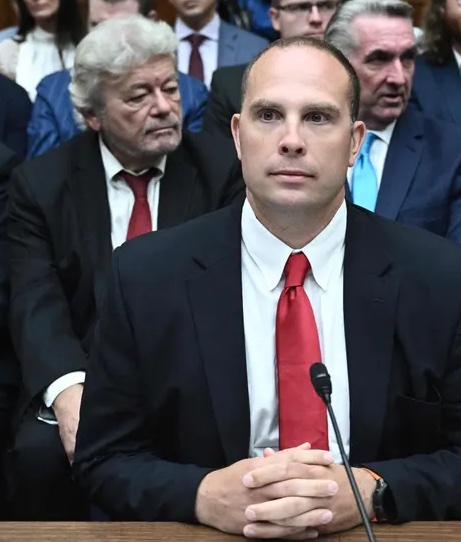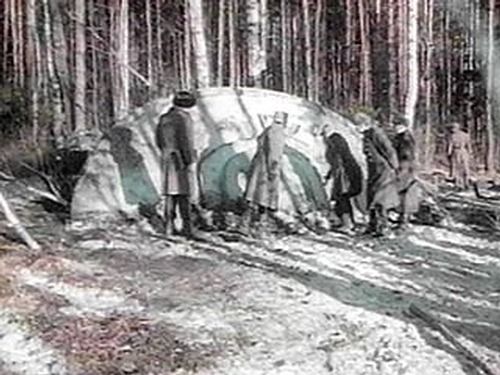by Charles Lear, author of “The Flying Saucer Investigators.”

Recently, on July 26, KLAS Chief Investigative Reporter George Knapp attended the House Oversight Committee hearing on UFOs. He submitted a written statement describing his interest in and involvement with the subject that was read into the record. A part of his statement that has made headlines is a description of an incident involving UFOs over a Russian ICBM base in Ukraine that seemingly took control of the base launch system. He said this story was to him by a man he described as the director of Russia’s official UFO investigation, Col. Boris Sokolov. According to Knapp, the study lasted ten years, “and was likely the largest UFO investigation ever undertaken.” As this is now in the historical record, it might be of interest to know how Knapp got in touch with Sokolov and consider how accurate his information might have been.

According to Knapp’s statement, his interest “in UFO secrecy” began in 1987, and in 1989, he “started hearing seemingly-outlandish tidbits regarding crashed saucers, strange materials, and reverse engineering programs being carried out in secrecy in the Nevada desert by intelligence operatives and defense contractors.”
Knapp wrote that the first person he shared his information with was Nevada Senator Harry Reid, and that this was the beginning of “a private, two-way conversation that continued for the next three decades.”
Another person Knapp says he spoke with was Robert Bigelow, founder/director of the National Institute for Discovery Science. According to him, they both had an interest in Russian UFOs, and in 1993, because of Glasnost, “there was a brief window of opportunity” for Western journalists to learn about subjects that were previously off-limits.
According to Knapp, Nikolai Kapronov, a Russian physicist, was in the U.S., and with the assistance of former U.S. Congressman Jim Bilbray, Knapp was able to meet him to talk about “arms control issues and nuclear detente at our national laboratories and nuclear weapons facilities.” He took the opportunity to ask Kapronov if he would be willing to find high-ranking people in the U.S.S.R. who had a knowledge of official Russian involvement in UFO research and investigation. He was willing and after 8 months, with an itinerary and an official invitation from Moscow, Knapp left for Russia along with two colleagues.
Knapp’s trip to Russia is described by one of his colleagues, Bryan Gresh, in the article (page 8 of the pdf) headlined “Soviet UFO Secrets” published in the Summer 1994 Flying Saucer Review Vol. 39, No. 2. According to Editor Gordon Creighton, the article first appeared in the October 1993 MUFON UFO Journal.
Gresh describes their Russian hosts as warm and friendly, and begins the article this way: “No meeting was ever complete without food.” According to him, they were in Russia for 10 days in March, and among the people they spoke with were: the head of the ongoing study of UFOs by the Ministry of Defense, “one of the architects of the Russian ‘Star Wars’ program,” and “a Russian scientist with first-hand knowledge of the reported crash of a UFO near Roswell, New Mexico, in 1947.”
Gresh describes them meeting Kapronov during a lecture tour he was on in the U.S. and learning that he and his fellow scientists, as well as members of the KGB and military, had talked among themselves about the UFO subject “for years.” Gresh and Knapp, who teamed up to produce a series of UFO documentaries (UFOs: The Best Evidence) set Kapronov up in Moscow with an office and a salary and asked him to find whatever “hard information” he could. Their initial thought was that they might be able to find information about American UFOs that the Russians had that might be under lesser security constraints than the same information in the U.S.
According to Gresh, in their search for “a treasure trove of UFO secrets,” retired Russian colonel, Boris Sokolov, was “one of the bigger gems.” Sokolov is said to have run a ten-year official study of UFOs, and according to him, “the entire Soviet Union became one gigantic UFO listening post” after an order came down from the Ministry of Defense that every military unit was to report all UFO sightings. According to Gresh, all reports ended up with Sokolov.
Sokolov said there were 40 cases of military pilot UFO encounters. According to him, they were initially commanded to pursue and shoot all UFOs, but after three crashes and two pilot deaths, they were told to avoid engaging with them. He said the pilots reported that the UFOs seemed to know how far to push the Soviet aircraft to where the pilot would lose control, and they saw them as a threat. Sokolov explained that the military was interested in UFOs as a possible source of advanced technology that could give them an edge against Russia’s adversaries.
According to Gresh, “October 5, 1983, is a date Sokolov will long remember.” Gresh then relates this story as told by Sokolov: On the aforementioned date, he was ordered to go to an ICBM base in Ukraine to investigate a report from the day before by the base commander that a UFO had been seen over the base between 4:00 p.m. and 8:00 p.m. During this period, the lights on the control panel lit up, and the launch codes were enabled. They got an order to prepare to launch, and fortunately, they didn’t. According to Gresh, six years later, in Soviet Military Review, Soviet military leaders made an argument that the Soviet Union should exchange information with the West in order to prevent a UFO-triggered nuclear exchange.
Another person Gresh says they spoke to was Rimili Avramenko, a scientist who worked on “Russia’s version of SDI.” Gresh says that Avramenko had a security clearance level so high that, “for much of his life,” he couldn’t use his real name when publishing papers. According to Gresh, he told them that by exchanging information with aliens, a plasma beam weapon was developed, which he referred to as “the weapon of the aliens.”
Gresh speculates that it was quite likely that Russian spies were in New Mexico in 1947 due to the atomic research going on there. He says that the next person they interviewed “made it seem apparent that, even in the 40s, the Russians weren’t buying the weather balloon explanation being proffered to the American people at the time by the US military.”
Gresh identifies that person as Valeriy Burdokov and says he told them about his acquaintance with the founder of the Russian space program, Sergei Koralyov, who, knowing of his UFO interest, confided in him and told him a story. According to Gresh, Koralyov told Burdokov that Stalin had called him to meeting in 1948 and brought him into a room where there “were piles of material and information collected during a top-secret study,” and that some of it came from New Mexico. According to him, Stalin asked him what he thought of the report of a crashed UFO near Roswell. He said he told Stalin that he’d need to take the material and study it for two days and that he’d then come back with an answer. He then said he was told he’d have to work in the room, which he did, and when he was done he told Stalin that the UFO phenomenon was real and that they weren’t made by the U.S. or any other country. He said that Stalin thanked him and said that many other specialists shared his opinion.
Burdokov is quoted expressing his views of the U.S. involvement with UFOs:
We know the United States Air Force possesses plenty of material. The U.S. Navy has a big amount as well. We know that special orders have been given to keep all materials secret. When curious people ask for the materials they are told they’re not there, that they’ve been destroyed.
Gresh ends the article hopeful that with the “new” Russia, there will be new opportunities for Russian and American UFO researchers to cooperate. According to him, an agreement was signed between their company and the Russian Academy of Natural Sciences “to establish a joint American-Russian research institute to foster the exchange of information between both sides.”
An article by Matthew Bodner headlined “Little Green Men: A Look at the Official Soviet X-Files Investigation” posted on March 31, 2016, on the website of The Moscow Times provides a different perspective. According to Bodner, the largest official Soviet UFO investigation was managed by the Defense Ministry and Academy of Sciences, was known in government circles as “The Network,” was started in 1978, ran for 13 years, and was headed by astrophysicist Yuly Platov.
According to Platov, they began their investigation with the help of private Russian researchers, primarily Felix Zigel, who was, in Bodner’s words, “considered by many followers to be the founding father of Russian UFO studies.” According to Platov, Zigel’s reports were all unverified witness accounts which Platov’s group was unable to validate. He said, “When he realized that we weren’t obsessed by looking for little green men, he drifted away.”
Bodner spoke with Joseph Kellner, “an academic specializing in the Russian UFO movement,” who described the efforts of the amateur investigators as “romantic” and rooted in a “suspicion of the academic mainstream.”
Daniel Galaydow, the official UFO correspondent for the Vechernyaya Moskva newspaper, added that a lot of their understanding of UFOs comes from “Western UFO mythology.” According Bodner, Galaydow “is skeptical of many reports from the 1990s, suspicious that jobless military and intelligence officers were creating stories to conform to Western UFO traditions, and then selling them to foreign UFO researchers.”
Podcast: Play in new window | Download